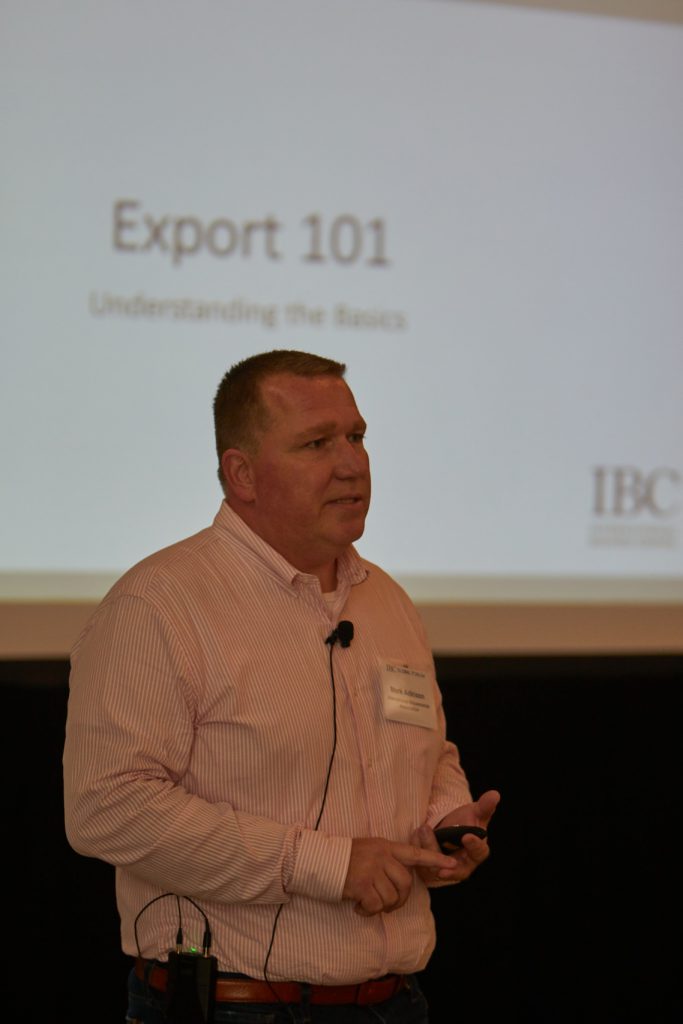Every fall, IHA presents the Global Forum, sponsored by the International Business Council (IBC), a special interest group of International Housewares Association members dedicated to increasing their international business.
The 2019 Global Forum, at The Guild Hotel in San Diego, Calif., opened Sunday afternoon at 4:30 pm with greetings from Mark Adkison, IHA’s vice president, international. Adkison welcomed attendees to the informative sessions planned for Monday and Tuesday and outlined the networking events as well. Sessions will be valuable for participants who are new to exporting or new to Global Forum and veterans will learn of new resources to help them in their businesses. The format this year includes presentations by IHA representatives from 10 countries who will summarize market and retail conditions in their respective countries.
He suggested several best practices for Global Forum: take advantage of all networking opportunities; develop a peer group and be open to listen and share (within appropriate limitations). Participants share what has worked for them and what hasn’t, without revealing confidentialities.
Adkison then dove into a one-hour presentation packed with information on Export 101: Understanding the International Business Plan. The presentation served as a primer for many aspects of managing an international operation and served as a refresher for experienced international marketers.

He discussed product selection, market selection, supply chain management, international marketing opportunities, sales channels, pricing strategies, exchange rates and the mechanics of export compliance. His outline provided a rich menu of topics for Global Forum participants to discuss for the next two days.
Each section presented numerous questions a company should consider before jumping into international waters. For example, starting with the very basic–product selection.

Product Selection
Adkison outlined a list of factors to consider in order to understand retail requirements and consumer needs in countries other than your own.
- What is selling today in this country? Visit stores to investigate your potential competition.
- Size Matters: on the retail shelf and in the consumer’s home.
- Packaging: How many languages should be translated and placed on the packaging to comply with local needs. Notice preferred types and characteristics of packaging for products similar to yours own.
- Compliance: for electrical products, food-safe materials certification
- Warranty: Think about how you will deal with repairs and defectives
- Modifications of your existing products.
Market Selection
Be Strategic, not reactive. Choose locales that have the highest potential for success as you consider these factors:
- Product suitability
- International travel–necessary for you and your staff
- Product and packaging
- Market by market review
Choose three counties. Often exporting to the closest neighbors are the most efficient way to grow. You are likely to encounter the least amount of friction with partners regionally close to you.
Understand Sales Channels
- Direct to retail. Long term growth plan should leave room for other partners in the future, try not to limit your future options.
- Distributor advantage: sales force in place and they already have relationships with retailers, challenges: they own the relationship and are protective. Set guidelines.
- Sales representative
- Export management company
- Direct to the Consumer retailers everywhere face competition from ecommerce
Supply Chains
A supply chain is an integral part of international sales process planning because it impacts both the cost of the item and the time it takes to deliver a product.
Tariffs and price increases are a big concern and will impact your cost of product, time to deliver and how much inventory retailers will commit to purchase. How you ship will impact your costs.
If shipping to other countries, you might save costs by maintaining inventories in that country. It can be worthwhile to keep a warehouse in or near the new markets to shorten lead times.
Adkison discussed several types of scenarios. For example, with direct import, you may shorten the time frame but find greater risk. If you ship straight from factory to retailer, what if something goes wrong with the products? If you are a new exporter, do you have quality control in that in that country? It’s crucial to build trust with the factory. And external circumstances impact all transaction, for example, Brexit will disrupt warehousing in the UK.
Information Sources
Adkison outlined some of the services IHA offers IBC members, beginning with the annual trade show. At our Inspired Home Show, IHA arranges one-on-one meetings with buyers, for example, and connections with other international trade fairs. He explained how the lists of buyers from the Show are arranged and what information is gathered. IHA’s website includes an IBC-members only section where country reports are posted regularly. IHA maintains offices and representatives more than 10 countries. The representatives reside in those countries and work in the industry so they know the state of retail in that country. Adkison also mentioned the IHA trade missions, which introduce member companies with sources and retailers in many countries.
Pricing Strategies
Be strategic about facing new competitors and their pricing structures. Consider the markets in your chosen countries and typical margins in each as your pricing will vary by sales channel.
Factors to consider when setting prices include your company’s export objective, market dynamics, costs associated with exporting the product, and sales strategy. Understand your true costs in order to set correct prices. Prices might be bottom-up—based on your costs, or top down—what the market can bear. Supply chain alternatives, sales channels, currency selection, exchange rates, collection/payment, letters of credit will all impact your pricing strategies. New tariffs may affect market conditions in the countries you had planned to enter and affect your profit margins.
- Consider currency selection and exchange rates. Who takes the risk of currency fluctuations? Be sure to develop flexible agreements for renegotiation.
- Collection and payment: Note proper terms of sales in each country. Do your contracts and invoices dictate proper bill of sale? It will be hard to build long term relationships with buyers if you require prepayment.
- Unique export costs: Consider IP and what to protect before entering new market so you can defend against predators and be sure margins will cover these costs.
- Global accounts: When working with global retailers, one might ask for the same prices as other partners. You will have to consider costs for shipping and other factors that will vary prices for each country.
Export Mechanics
Familiarize yourself with INCO terms. Introduced in 1936 by the International Chamber of Commerce (ICC) these terms are the basic vocabulary of the business. Learn the international rules for interpretations of the most commonly used international trading terms. This will reduce or remove uncertainties arising from differing interpretations. The latest Incoterms were just released and come into effect Jan 1, 2020. Visit the ICC website to get a copy.
Shipping
Adkison outlined various aspects of shipping considerations and suggested participants take advantage of IHA’s partner agency, the IHSA, which offers key benefits to members. IHSA negotiates space on cargo ships has leverage to negotiate rates. IBC members benefit from such discounts.
- Freight Forwarder
- Arrange international shipments
- Prepare and process documentation
- Commercial invoice
- Shipper’s export Declaration
- Automated export system
- Bill of lading
Export Compliance
Exporters must comply with product and packaging regulations in other countries. For products, this may include rules about materials used and in packaging language, metric measurement and labeling are typical considerations.
Shipping compliances will note dangerous goods, such as aerosols, pressurized products, alcohol, cleaning products and chemicals.
Customer Compliance
These lists are continually changing, so be sure to check the Denied Persons List and Debarred Parties, as well as Sanctioned Countries. It’s your responsibility to make sure your products/shipments are not diverted to sanctioned countries.
Tips for Your International Business
Planning
Summarizing the international business plan, Adkinson noted that international sales staff will have to secure corporate buy-in and engage senior management and category managers
He suggested www.productip.com consulting services as a good resource for tips on requirements for getting into new markets and https://www.export.gov/How-to-Export which features many informational videos and visit the IBC blog to learn more.
Questions from participants asked about the reports IHA’s representative prepare and the retail buyer information IHA gathers. Adkison previewed the presentations that attendees will hear in the coming sessions from representatives who will speak about markets in the UK, France, Scandinavia, Taiwan, Italy, Colombia/Equador, India, Australia, Brazil and Mexico.
After the educational session, participants enjoyed the garden reception and dinner and met IBC board members. Global Forum attendees refreshed continuing friendships with their peers and met first-time attendees, whose badges with the green dot identified them and inspired welcoming conversations.







